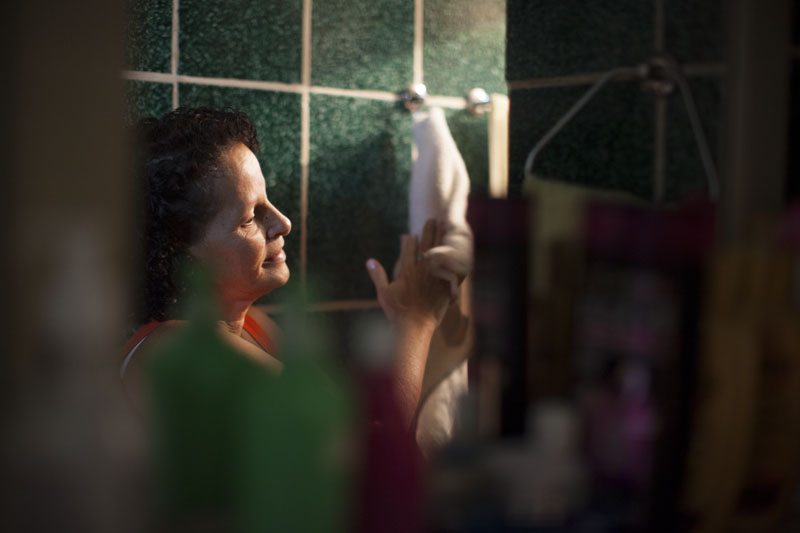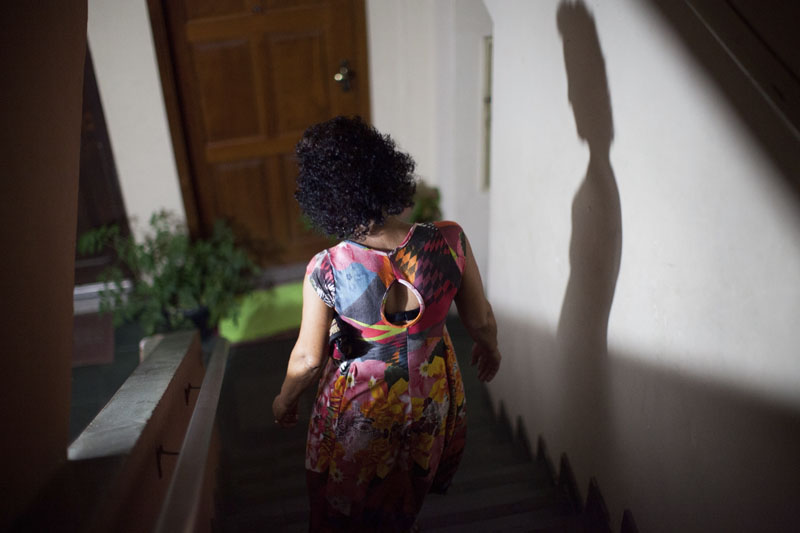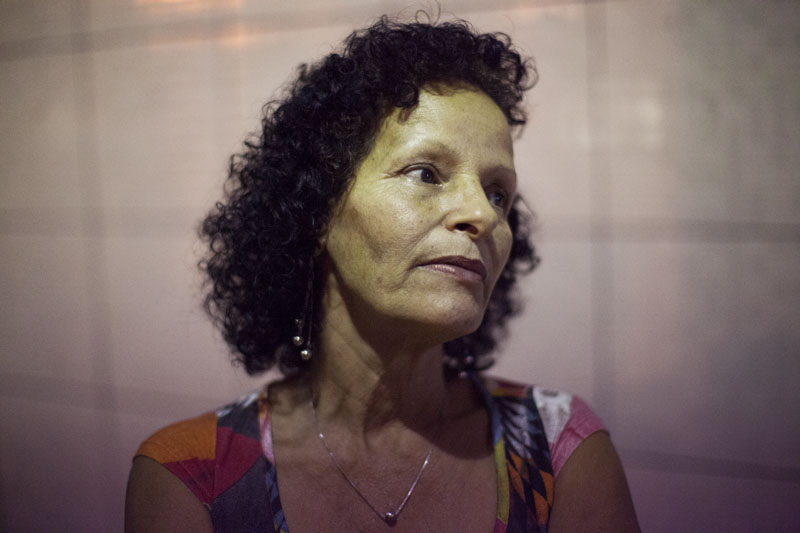IARA:
RECOVERING FROM THE CURE
Text by Shehryar Nabi
Photographs by Misako Ono
Video by Samuel Costa
““I say and I repeat,” stresses Iara. “Interferon was the end of my life.””
Iara Pereira has come a long way since she took interferon in 2006 to treat her hepatitis C. Her hair, curly and dyed black, is fully regrown. She is exuberant and active, showing no signs of the overwhelming exhaustion she felt while on her treatment. All day, she bounces energetically from task to task in her apartment: scrubbing deeply into wet clothes, folding clothes to dry on the window sill, chopping onions for lunch, sweeping the block toys her neighbors’ children were playing with and bathing her seven-year-old granddaughter, Ketlyn. Being around kids makes her happy. “You forget everything when children are in the house,” says Iara. “They are my therapy.”
Iara makes a living cleaning apartments in her building and babysitting her neighbors’ children. The hallways of her building are open air, and she leaves her front door open during the day so she can greet and joke with neighbors. The hallways are spaces where the neighbors interact. From these balconies you can see all along the apartment blocks, clothes hanging out to dry from windows, cars and people moving on the streets nearby, and the distant hills dotted with houses looking down on the city of São Gonçalo.
In her apartment, Iara makes high-spirited conversation to the background noise of the neighborhood: children shouting in the street, music and news from television sets in nearby apartments and political slogans for candidates in local elections blasting from cars driving slowly by. Sunlight beams into her cozy living room through the open doorway and window that let in a light breeze, making the folds of her sofa covering and dark blue curtains sway gently. Savory smells of frying onions and spices emanate from her kitchen. The coffee she makes brings neighbors to her front door. Her son, who lives in an apartment downstairs, will often come up and grab a cup for himself. “He doesn’t say hello, he just takes the coffee,” Iara says with a laugh.














Like many other people in Brazil who are diagnosed with hepatitis C, Iara was unaware of its effects before she knew she had it. She discovered she had the disease in 1998 when she tried to donate blood for a friend with hemophilia. At the time, she said she did not have a reaction to the news because she had no knowledge of the potential consequences of the disease, such as cirrhosis of the liver and cancer. Upon learning the severity of the illness, she was overcome with shock. Iara had no idea how she contracted hepatitis C. She could not recall an instance when blood was transfused into her system, and she was never an injection drug user. After she revealed the diagnosis to her family, she was briefly isolated from them because of their ignorance of the disease. “They avoided contact with me because they didn’t know anything about it,” says Iara.
Although she was not suffering from any of the symptoms of hepatitis C, doctors urged her to begin taking treatment to prevent the disease from damaging her liver. She applied for interferon treatment in 2002, but it took four years to navigate the bureaucracy of the public health system. “I called every week and went to see the Secretary of Health in Rio,” Iara recalls. “It was all very tiring.”
She finally started her treatment in May of 2006, when she began commuting to a hospital in the nearby city of Niterói. For the next three months, she experienced the worst pain she ever felt in her life. The side effects were devastating compared to the absence of symptoms she felt before taking the interferon. “I felt like I was having a heart attack,” says Iara. “It was like someone was putting a knife into my heart.”
In addition to interferon, she was prescribed a supplement of ribavirin to take every day. She had a unique reaction to the combined medicines – especially from the interferon – that resulted in an uncommon number of side effects compared to others undergoing the same treatment. By that August, Iara had dropped eight kilograms (more than 17 pounds), lost her hair, and accumulated rashes and wounds all over her body. She also acquired a number of illnesses that included stomatitis, anemia, hypothyroidism and depression. Although she was willing to continue the treatment after her last week, her doctors found that the disease had gotten worse, not better. They ordered her to stop the treatment at the risk of death.
Anemia, an effect of the treatment that prevents the body from getting enough oxygen, made Iara severely fatigued. She did not have the strength to do even the most minimal daily activities, like walking down the stairs of her apartment building or lifting a liter of milk. The fatigue could hit her at any time. While out walking, she would have to stop at random moments just to rest. Once, while visiting her son’s house on top of a hill, she only had the strength to crawl. “I was ashamed to go out into the street,” says Iara.
She also could not control the bouts of depression. But she never accepted them. She refrained from taking antidepressants, favoring the comfort of her family and the responsibilities she had as a mother and grandmother. “You need to look in the mirror and say, ‘You don’t need to get depression. You have children. You have grandchildren. You need to fight this,’” says Iara. “When you’re thinking of them, it’s just like an antidepressant.”
Although Iara’s health improved dramatically after ending the treatment, she still has not fully recovered. She has not been able to regain the weight she lost, despite taking special vitamin supplements. Her experience with the treatment has also made her very cautious about trying other antivirals that could potentially cure her hepatitis C. She is decidedly finished with interferon. “I say and I repeat,” stresses Iara. “Interferon was the end of my life.”
Iara’s current symptoms from hepatitis C are relatively mild – some pain in her arm, itchiness, and a bitter taste in her mouth. But she still has to be very careful with the medicines she takes for other illnesses. She has to avoid anything that might affect her liver. There are often no available medicines that suit her, and doctors subject her to endless examinations without prescribing anything. A month ago, Iara had a urinary tract infection that doctors could not immediately provide treatment for because of the risk of exacerbating her hepatitis C. Until the proper medicine was available, she could only soothe the pain by lying on an ice pack.
Despite her painful experience with interferon, Iara believes that with good information, she will find a treatment that suits her. Because of her uncommon reaction to medication, other people’s testimonials to the different drugs are crucial. The Ministry of Health does not release the information she needs, so she relies on the internet and her hepatitis C support group, Grupo Amarantes. From this source, she learned of the new drug Sovaldi, which has a 90 percent cure rate and almost no side effects – although it is currently unavailable in Brazil’s public health system.
Iara is a key member of Amarantes, where her humor and lively character provide great relief for fellow members.Despite facing many challenges, such as lack of government funding for a continuous meeting place, the group has inspired Iara. She was particularly moved when another member of the group defined herself as a full body of organs and not characterized solely by her liver. Iara repeats the statement for herself, “I can do many things – I am not just a liver.”
Today, she maintains her strength by challenging herself in the smallest of activities. Sometimes, she holds imaginary competitions with people in the street. “One time I saw an old man in front of me, and I walked so fast to get to the bus station to beat him,” says Iara. “I looked behind me, saw the old man, and said to myself, ‘I win!’”
Iara is keen on making every moment of the rest of her life count. “A gypsy told me I would die at the age of 70,” says Iara, who is now 57. “Okay, it’s enough for me. But until then, I want a higher quality of life. I want to dance more. I want to enjoy things more. And then if I die, it’s ok.”
On Sunday nights, when São Gonçalo is alive with barbecues, young partygoers and open air bars, Iara makes an effort to go to Pimpão, a party for seniors. Before going, she talks about the dance while performing the movements in a festive dress made up of intricate floral and checkerboard patterns of red, yellow, blue, orange, purple, white and black. When she arrives at the party venue, perfumed women in colorful dresses and men wearing dress shirts – with enough buttons open to reveal puffs of white chest hair – trickle inside as the music starts. While they stand on either side of the dark dancehall, shyly swaying to the beat of 70s funk and eyeing different corners of the room, Iara dances without restraint. The party accelerates when the DJ plays classicsertanejo, a style of Brazilian pop music. Soon, a man asks her to dance and she blends in with the other couples in the room, illuminated only by the swirling blues, greens and reds of the disco lights.
